► Latest Flying Spur Speed driven
► 771bhp hybrid tested in the UK
► Immensely capable, occasionally frustrating
The latest Bentley Flying Spur Speed is the fastest and most powerful Bentley four-door ever. Probably not a massive surprise, as there’s a lot of that sort of thing going around at the moment – almost always the result of some form of electrification. As here, where Bentley has finally found a suitable substitute for the fabulously complex and compelling W12 engine in the form of a new V8 plug-in hybrid powertrain.
Referred to by the company as its Ultra Performance Hybrid system, it uses components co-developed with Porsche to produce a not insubstantial 771bhp in this application. Enough to see 0-62mph disappear in a luxury-lined 3.5 seconds.
More importantly, compared with the previous and slightly underwhelmingly V6-powered Flying Spur hybrid, you get a greater electric-only range and a more powerful electric motor to make the most of it. Plus upgraded suspension and other revisions.
We’ve been driving the new V8 hybrid Flying Spur Speed in Arizona, where the roads are winding, the gradients epic, and the pick-up trucks so large they make even a Bentley seem demure. (Here’s how we test cars.) Following the launch, we’ve now had the chance to test the Flying Spur on the UK’s uniquely challenging roads.
At a glance
Pros: V8 PHEV power the perfect fit for Bentley, chassis now more dynamic and yet also more comfortable, fantastic interior
Cons: Tiny boot, some potential – and, for us, minor – irritation with the brake pedal
What’s new?
Visual differences between this updated Flying Spur and the model it replaces are very few, for the big saloon is receiving its drivetrain upgrade far earlier in the planned model cycle than the Bentley Continental GT. So while the 2024 Continental GT got a full facelift, the 2024 Flying Spur has been subject to the merest of nips and tucks.
Get the monocle out and you’ll note tweaks to the front grille (largely to accommodate a new sensor package), changes to the lower sections of the front and rear bumpers, a different alloy wheel design, and that the Speed’s already subtle body kit is now painted the same colour as the rest of it by default. Visible carbonfibre does remain an option for this, though. The brightwork is dark-tint now, with the shiny stuff reserved for the forthcoming and fully loaded Mulliner variant.
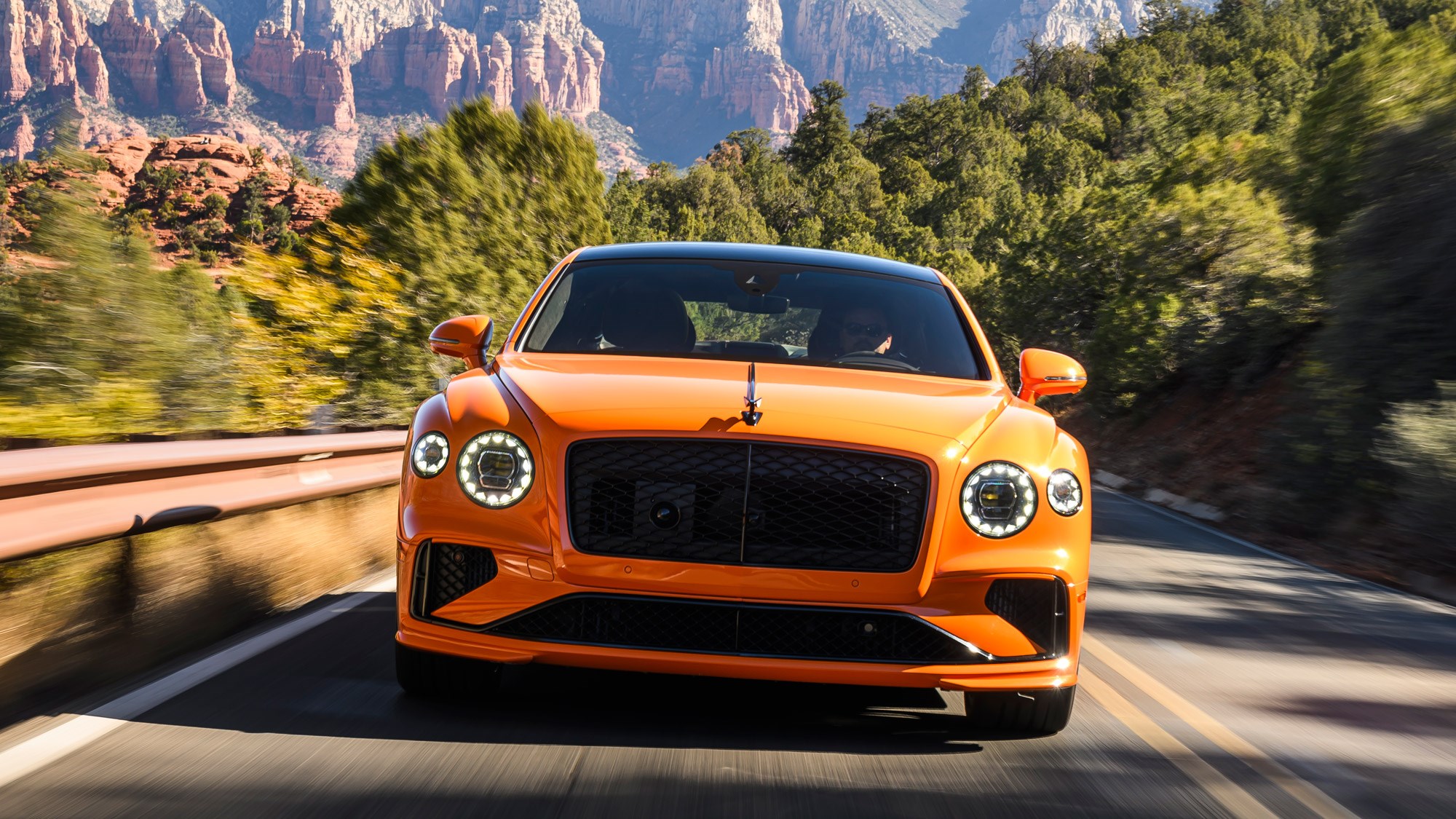
Since replacing so much of the drivetrain meant tearing up so much of the existing electrics, Bentley’s also gone in with a new infotainment system on the inside. Where you’ll also find new Precision Diamond 3D-patterned surfaces and optional Wellness seating for all four main occupants (you can have a fifth seat, but it’s really more of a perch).
Keeping driver and passengers suitably suspended, there’s also new two-chamber air springs and dual valve dampers. The dampers Bentley describes as its ‘secret weapon’, since they allow fully independent adjustment of compression and rebound. The rest of the chassis hardware – which includes active all-wheel drive, rear-wheel steering, active anti-roll bars, and a rear eLSD – has been recalibrated to match these enhancements as well as the powertrain.
What are the specs?
Up front there’s a new-to-Bentley 4.0-litre twin-turbo V8. Co-developed with Porsche and built in Zuffenhausen, this produces 591bhp on its own and eschews recent ICE intricacies such as twin-scroll turbos and cylinder deactivation since it’s attached to a 188bhp electric motor.
Tucked inside the eight-speed dual-clutch gearbox, this e-motor torque fills at low rpm to compensate for the single-scroll turbos and makes it easier to turn off the whole engine than knock out just half the cylinders. It also delivers 47 miles of WLTP electric driving range via a 25.9kWh battery pack. Electric-only motivation is available up to 87mph and 75 per cent accelerator application.
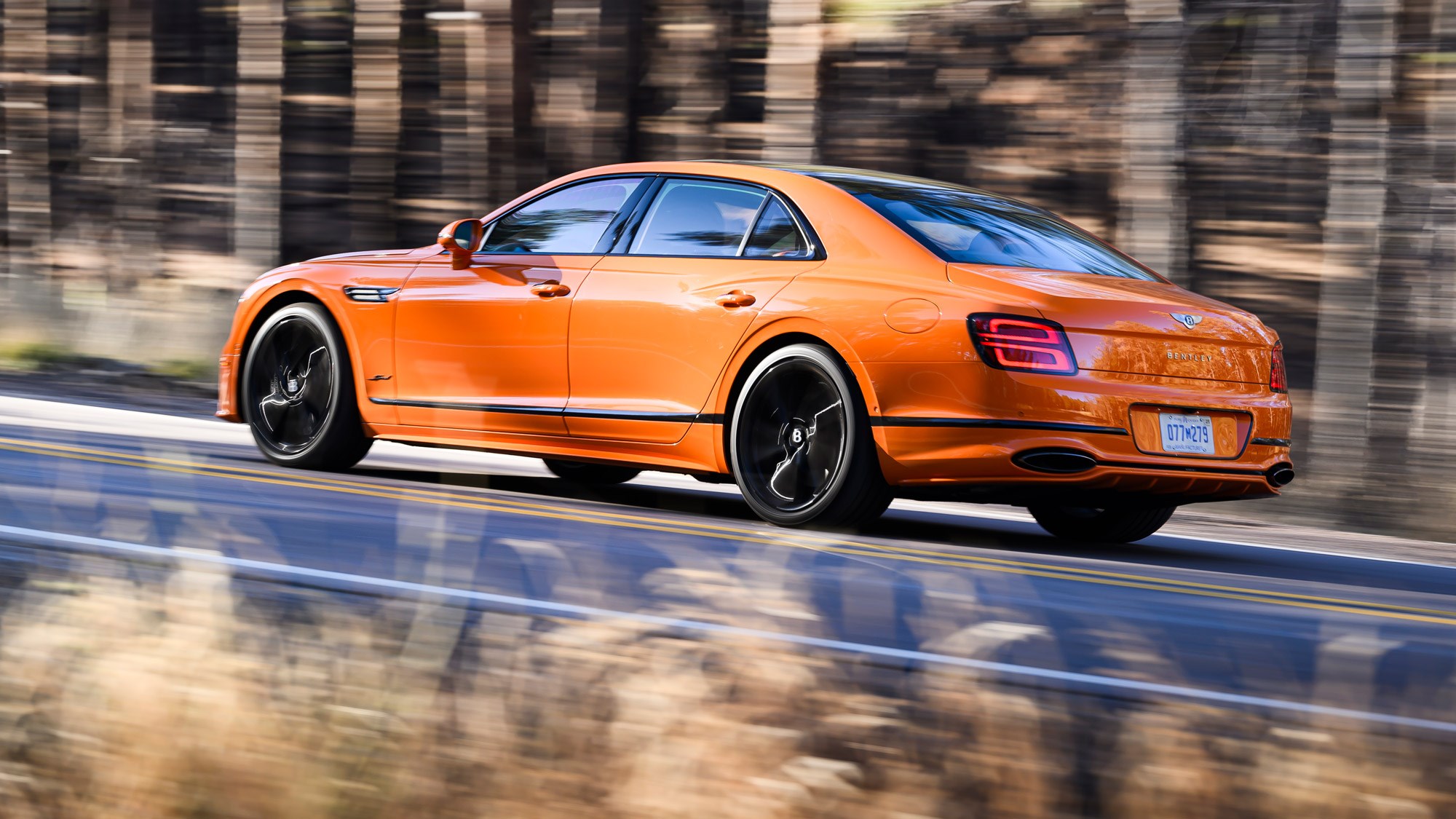
Maximum system power is 771bhp while maximum system torque is 738lb ft. That last is vaguely interesting, in that when measured independently, the V8 makes as much as 590lb ft and the electric motor an instant 332lb ft. So you can see how the one compensates for and complements the other. This is not a car that’s troubled by a lack of fortitude.
Single scroll turbos can run hotter, so the engine can run leaner, which has a useful impact on efficiency – though not as much as the battery pack does. The usual WLTP oddities mean the official CO2 figure is 33g/km with a combined fuel economy of 202mpg; in the real world it’s not impossible to reach 40mpg at a gentle cruise, though it’s equally not difficult to hammer that way down again with any sustained bout of vigorous exercise.
Given this Flying Spur weighs just shy of 2.7 tonnes, the former is more impressive than the latter is inevitable. As mentioned, 0-62mph in the V8 hybrid takes 3.5sec; for context, peak W12 Flying Spur produced 626bhp with 664lb ft, and 0-62mph in 3.8sec. Charging the new car’s drive battery takes at least 2 hours 45 minutes, however – though you can at least top it up via the engine while driving now, something that wasn’t possible in the previous V6 hybrid model.
How does it drive?
The Flying Spur has always been something of a velvet thug – looking like a business jet but really wanting to behave like a fighter. In this latest generation, with its much crisper body lines and tautly honed flanks, that athleticism shows through the suit a little more, even when the entire thing isn’t painted like a nuclear sunset (the colour is called Mandarin, and costs £18,775).
So while we’re not totally (or in fact, at all) convinced about Bentley’s claim that this is the world’s first four-door supercar, it is both very fast and very capable. For instance, the new spring and damper combo not only allows Bentley to widen the scope for improved ride quality in Comfort while maintaining body control in Sport, it enables variation in the understeer balance with the driving mode as well. This works in tandem with the all-wheel drive and all-round torque vectoring, making Sport determinedly more rear-biased than before.
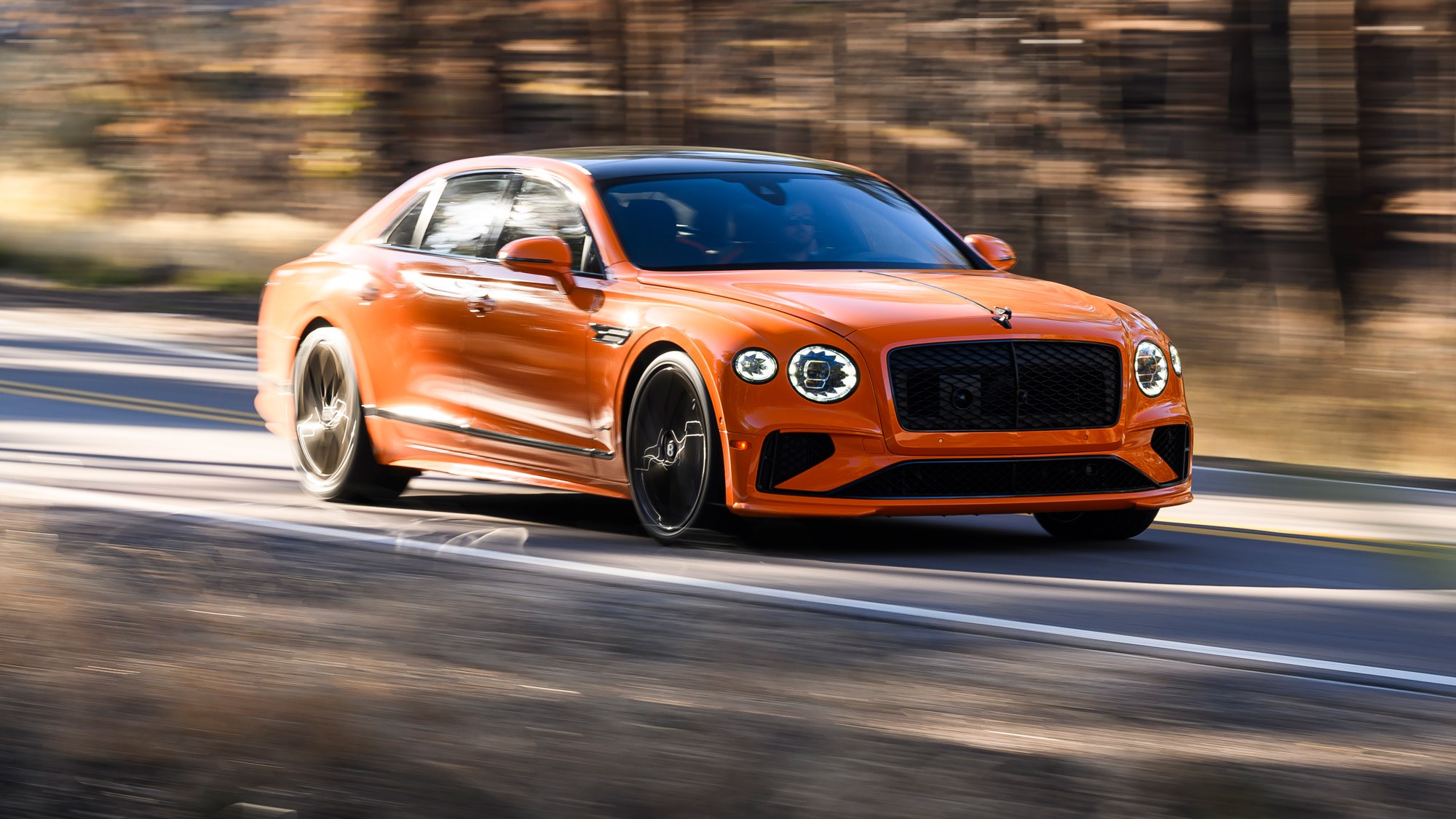
Underlining this point, you might have seen the rather silly / slightly cringy Bentley marketing film with Damon Hill and Lia Block, demonstrating this new-found driftability. And yes, if the orange car we’ve been driving in the States looks familiar, you’re not imagining it – a change of tyres and it’s been put back to work on the press fleet.
To be honest, drifting is not especially high up the agenda on the remarkably busy public roads around Arizona. But with the sweeping turns and immense, swiftly realised altitude adjustments of the dual carriageways that thread an astonishing variety of mountain ranges punctuated by rapidly driven and variably loaded pickup trucks, this is a fine opportunity to explore more relevant dynamic parameters.
And pushing all comments about the orange aside, this new Flying Spur is majestic. The chassis changes don’t go as far as the latest Porsche (and Audi) revisions that include pitch and roll controlling active ride, but Bentley can still torque the 48v anti-roll system to resist lean, or entirely decouple opposing wheels as the surface and comfort requirements demand.
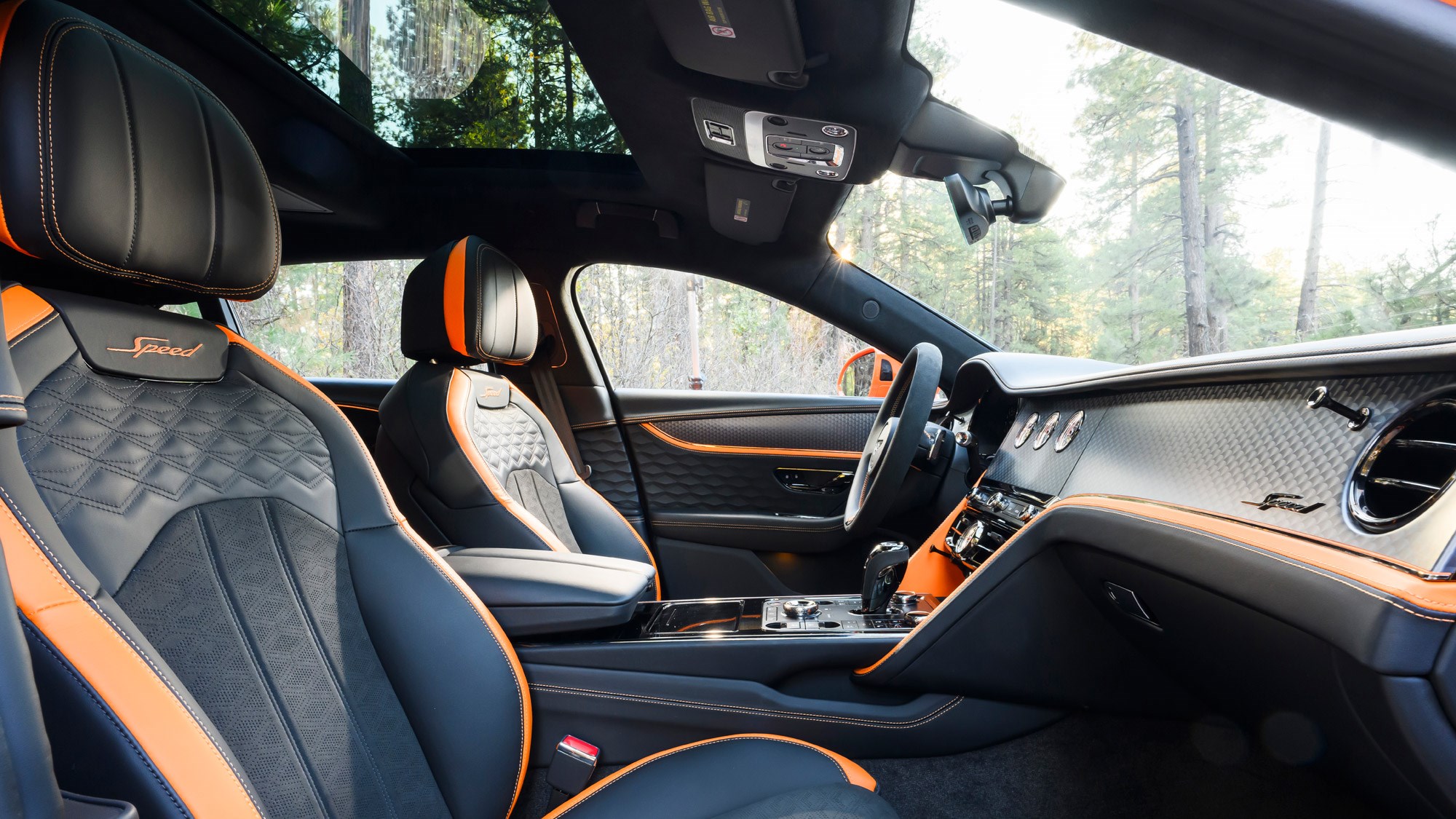
While the result isn’t quite as multifaceted as those VW Group compatriots, which now have a truly enormous breadth of talent, the more natural feeling progression of the Bentley’s fundamentally conventional suspension is certainly less disconcerting than their counter-leaning trickery. (Though this can be switched off, of course.)
The Flying Spur’s most muted Comfort setting will easily take the sting out of rippled tarmac, and it hardly wilts in the corners. But if you need to press on, the weightier-helmed and more exuberantly soundtracked Sport certainly delivers on its promise, allowing you to carry speed through direction changes with greater confidence. At the cost of greater annoyance with the surface imperfections.
Between the two sits the finally judged Bentley mode, which moderates some of the patter – and the volume – without giving up all of the control. It feels like an excellent default, though you can set custom parameters if you prefer. Regardless, the smooth, rapid action of the gearbox and the thumping performance from that powertrain means we can pick off the pick-ups at will, the Alcantara edging to the steering wheel adding an unexpected detail to the tactility of the driving experience.
Topping it all is that PHEV flexibility. Gliding silently through populated areas promotes a serenity you can then shatter as the mood takes you by deploying the full 771bhp and 738lb ft the moment the houses peter out and the road begins to climb and sway. Mostly the transition between power sources is extremely smooth, but we did note one rather abrupt reversing manouevre in e-mode, where nothing happened for a second before an unseemly jolt heralded a more-rapid-than-intended bout of backwards acceleration.
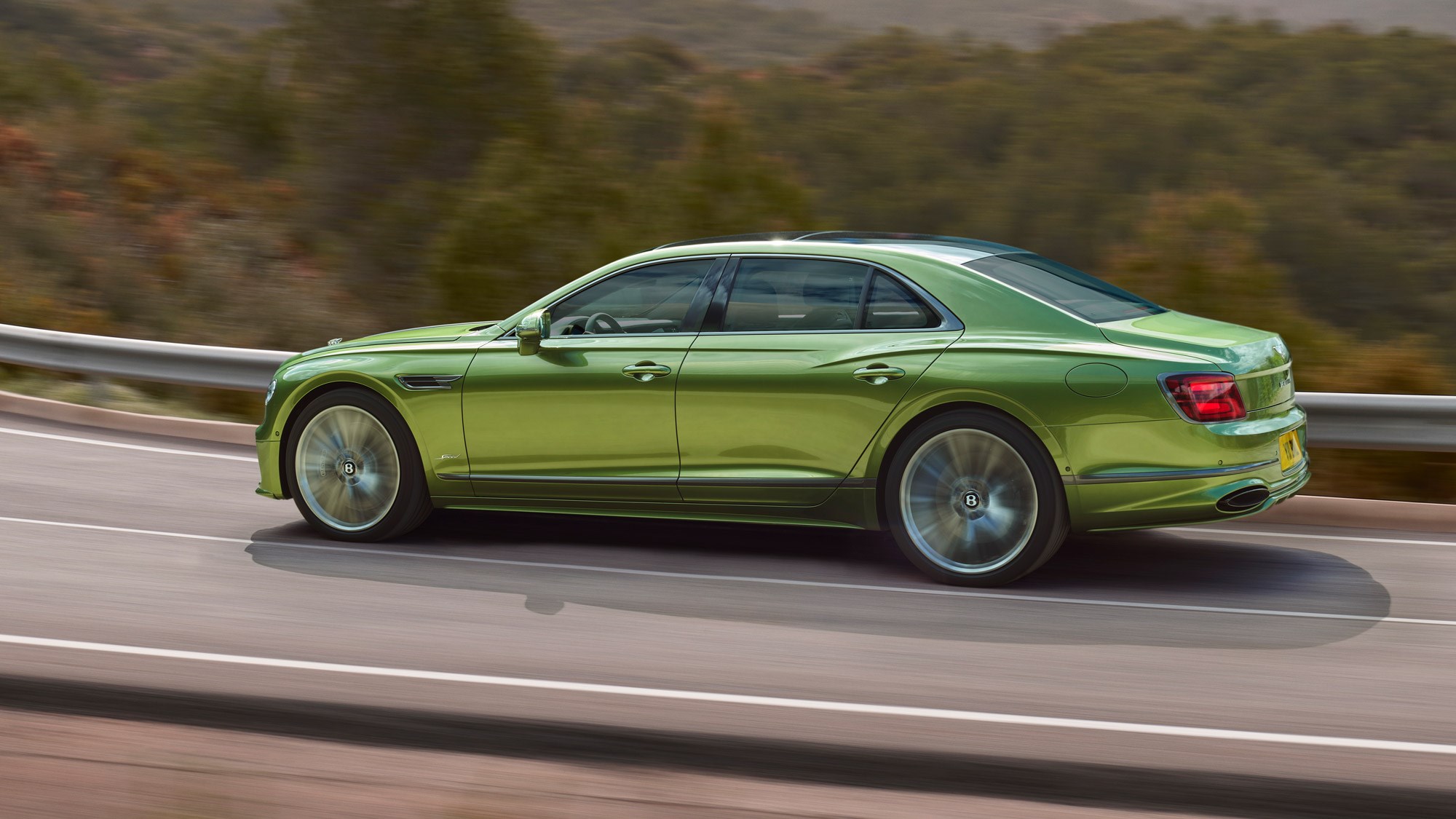
The dual-clutch gearbox’s auto setting is smooth in traffic, but for more enthusiastic driving we found it a little too keen to keep shifting gears and chase higher revs, no matter the mode it was in (though naturally Sport was most extreme). Better to change gears manually using the paaddleshifts and work the mid-range torque.
Not everyone will enjoy the dancing brake pedal, which flickers beneath your foot whenever the electric motor’s regen capability kicks in to slow the car in its stead. In fact, when the car juggles braking and coasting in traffic it can actually be a less comfortable for those pampered rear occupants, simply because progress isn’t as smooth as an attentive driver judging the flow of traffic far ahead. At least it turns itself off in the Sport setting.
UK roads revealed the Spur’s chassis to be equally dextrous as we discovered in the US. It compresses indulgently on its air springs in Comfort mode, smoothing over even the worst surfaces, and while ‘B’ for Bentley mode tightens up the body control and lets a few more imperfections slip through the net, it remains hugely comfortable. In fact – and unusually – Sport mode remains perfectly useable on the road, though it’s best saved for spirited runs one-up due to its much firmer set-up.
Driven like that, the Spur couldn’t support the weight of the V8 over its front axle quite as robustly as the Continental GTC we tested recently and which shares the same drivetrain, but it’s very able nonetheless for such a large car, allowing you to lean on the front end grip quite confidently.
The steering never quite shakes its slightly wooden feeling, but it boasts good on-centre definition, responds promptly to small inputs and has a consistent, meaningfully weighted precision as you wind on lock.
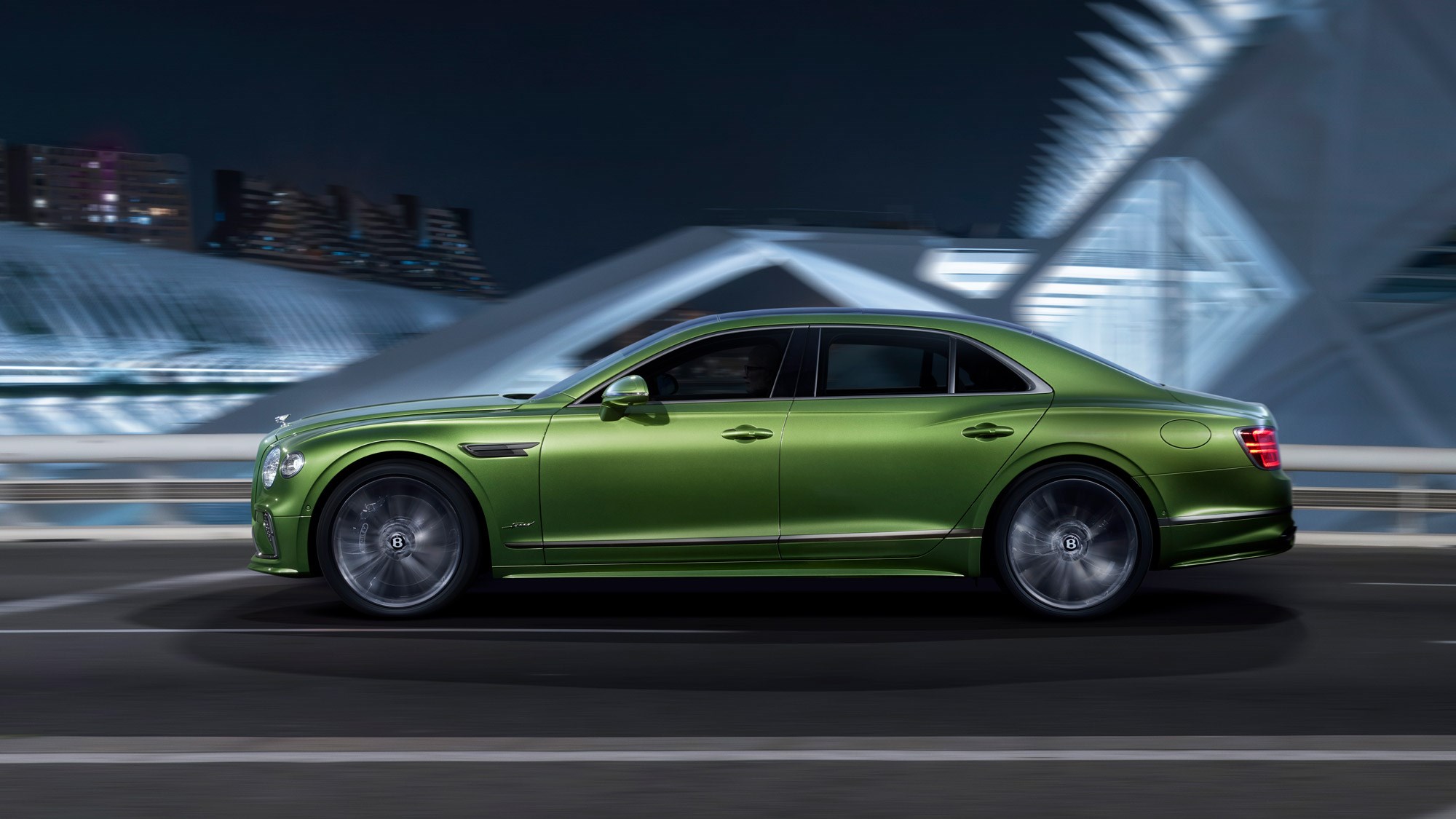
Rear-wheel steering is obviously present, but it’s neatly integrated and makes the Spur far wieldier than something so long and heavy has any right to be. Add to this all-wheel drive that’s gently throttle-steerable and the Flying Spur feels a surprisingly biddable machine point-to-point, with ultimately its sheer width proving the limiting factor.
We did, however, also note the LED Matrix headlights left large areas of darkness on an empty B-road, so that the corner apex was often unseen even if everything was floodlit.
What about the interior?
No major changes on the inside for this powertrain update, so the Flying Spur continues to be both splendidly constructed – from a vast choice of available materials – and a bit of a button fest.
For while there is a welcome new infotainment system, with native app integration (so you can use Spotify, for example, without connecting your phone) and other fancy modern features, you still get physical climate controls and a centre console that, though initially confusing, can be navigated by muscle memory over time.
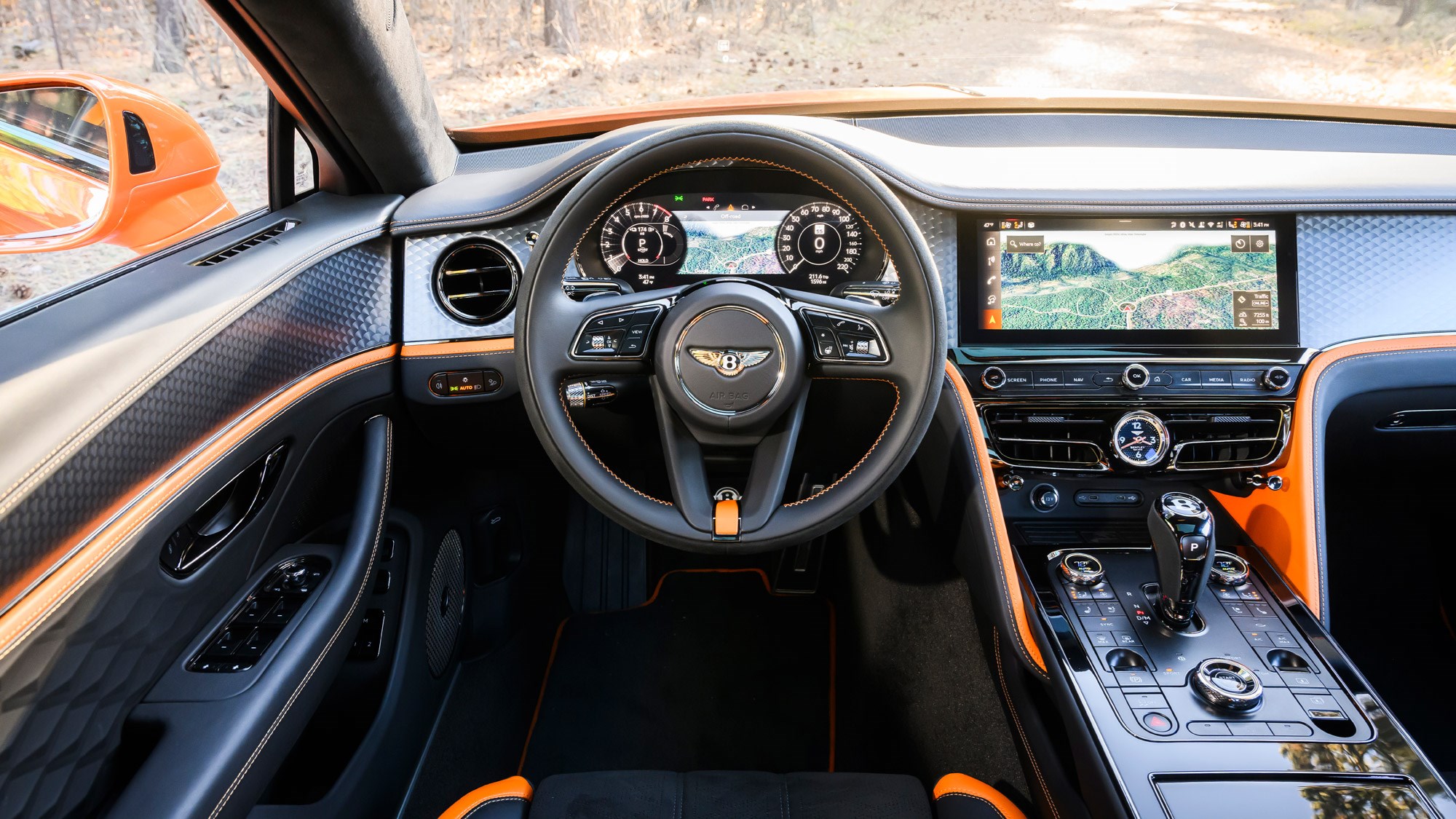
The optional rotating display, affectionately known as the Toblerone, means you can hide the infotainment screen, in favour of a three analogue dials or just a blanked section of dashboard. There’s no escaping the digital instrument cluster, but this is clear and easy to get to grips with.
The new Precision Diamond finish on the upholstery is eye-catching, while the optional ‘wellness seating’ for four passengers provides constant micro support and climate adjustment. The sensation of it tweaking the padding beneath you, seemingly at random, takes a little getting used to. But it’s hard to argue that it doesn’t reduce fatigue as you drive.
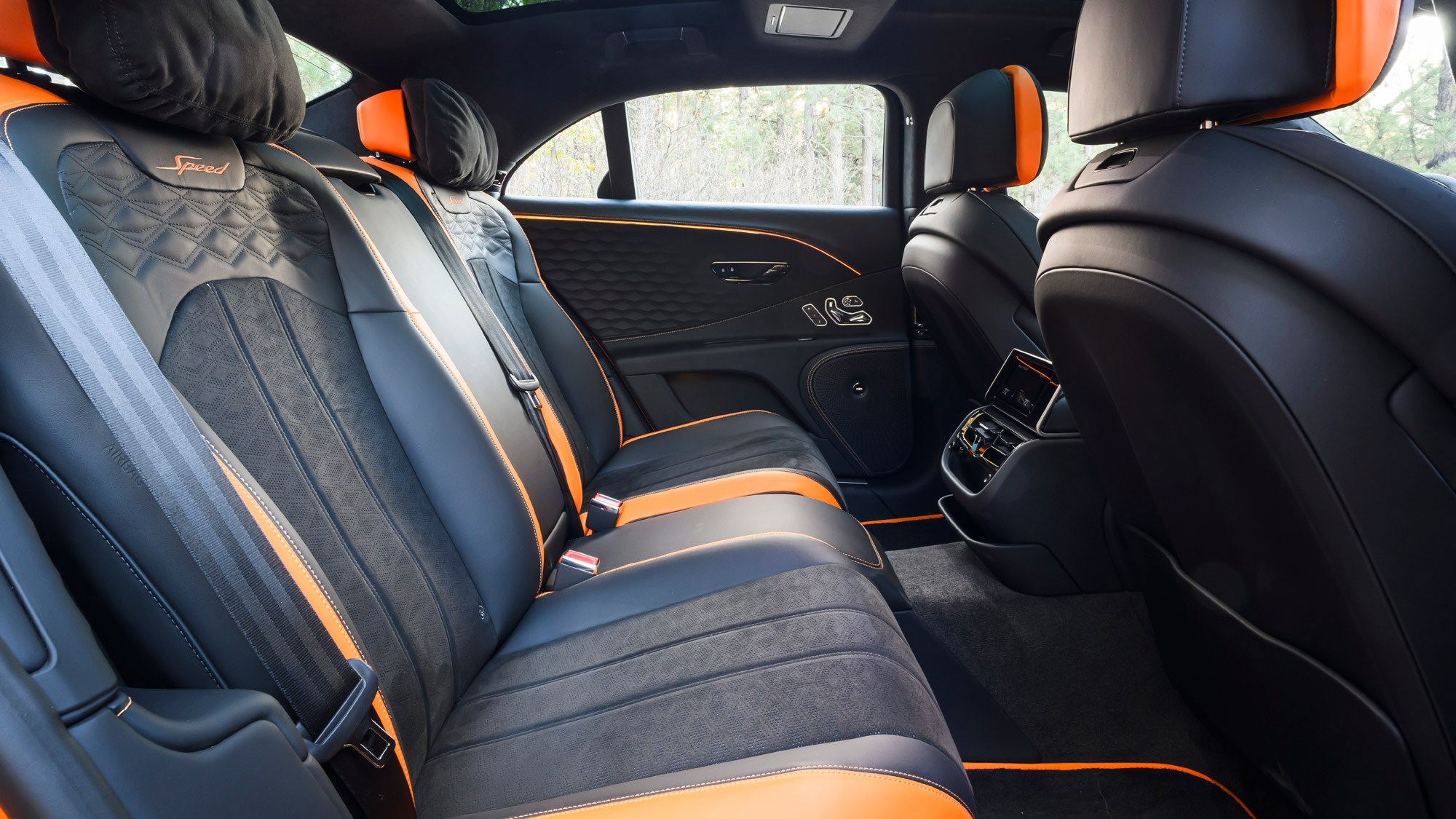
We’re not really sure how useful the bespoke touchscreen remote control available to rear seat passengers actually is – oddly you can’t seem to control the radio with it. But overall, the intricacies of the interior, together with such definitively crafted comfort, make travelling in the front or the back a rare joy.
Before you buy
Couple of things to note before you pull the trigger. Firstly, the boot is hilariously tiny at just 346 litres (the Fiat Grande Panda Electric‘s is bigger). You may genuinely need to send the luggage on ahead. And secondly, though this thing has a basic price of £226,500 there are a lot of items you’re really going to want from the options list. Don’t plan on getting out of Crewe without spending close to 300 large.
As for rivals… well, you could buy an AMG S-Class or a really fancy Panamera. Perhaps a Purosangue. But if you want a big, ostentatious saloon that can deliver deep pleasure to both driver and passengers while encasing them in absurdly tasteful (subject to personal restraint) handcrafted excellence, there isn’t really anywhere else to go. Assuming Goodwood doesn’t quite meet one’s requirement for sportiness.
Bentley Flying Spur V8 Hybrid: verdict
At this end of the market, so much comes down to individual preference. But if you’re looking for reassurance, our experience of the Ultra Performance Hybrid in the Bentley Flying Spur Speed suggests that if you want and you can, you really should. This is a luxury car to indulge with and enjoy, and plug-in hybrid power – especially at such a decisive level – is perfectly right-fit for this brand.